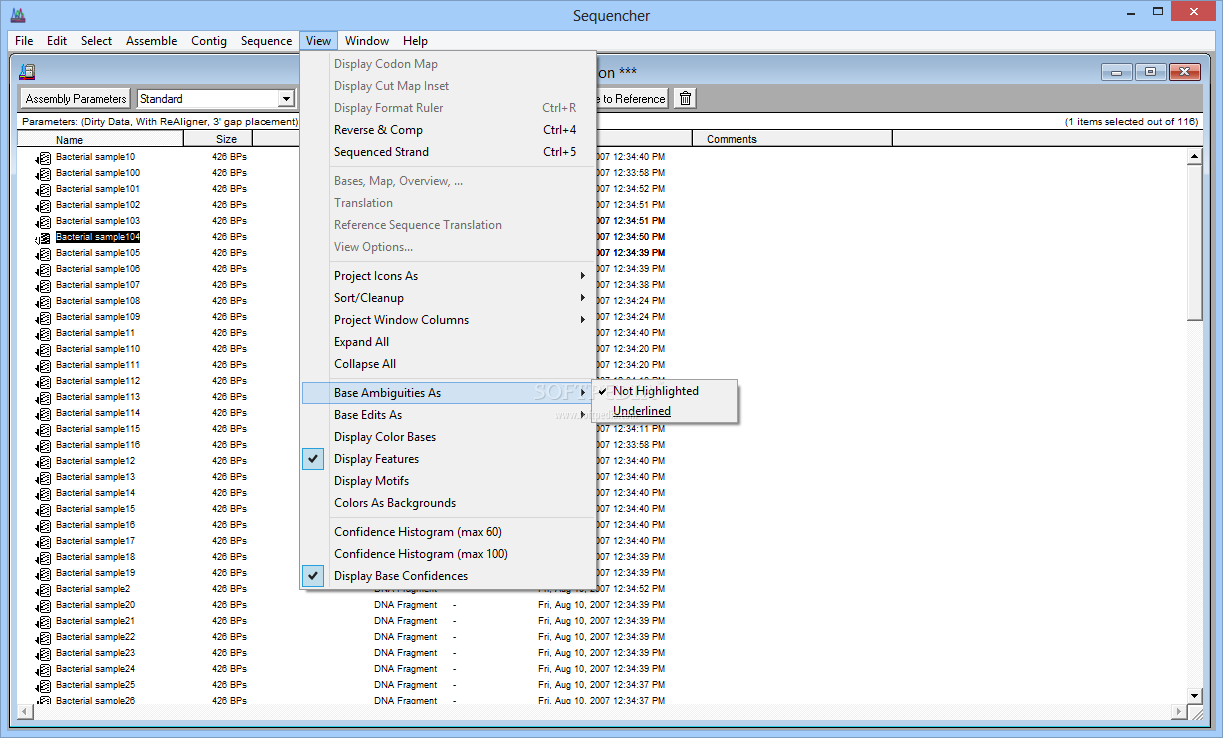
to determine a sequence of base calls from the processed DNA sequence tracing: Phred uses a four-phase procedure as outlined by Ewing et al.

It is also used by the MacVector plugin Assembler. Phred is distributed commercially by CodonCode Corporation, and used to perform the "Call bases" function in the program CodonCode Aligner.
#Sequencher export consensus software#
It was at the time the most widely used base-calling software program by both academic and commercial DNA sequencing laboratories because of its high base calling accuracy. Phred played a notable role in the Human Genome Project, where large amounts of sequence data were processed by automated scripts. Green moved to University of Washington in the mid 1990s, after which development was primarily managed by himself and Brent Ewing. LaDeana Hillier, Michael Wendl, David Ficenec, Tim Gleeson, Alan Blanchard, and Richard Mott also contributed to the codebase and algorithm. Phred was originally conceived in the early 1990s by Phil Green, then a professor at Washington University in St. To meet this need, many software programs have been developed. To remove the bottleneck, both automated software that can speed up the processing with improved accuracy and a reliable measure of the accuracy are needed. interpreting the trace data to produce the sequence data), thereby creating a bottleneck. However, the sequence data is produced at a significantly higher rate than can be manually processed (i.e. Since the intensity, shape and the location of a fluorescence peak are not always consistent or unambiguous, however, sometimes it is difficult or time-consuming to determine (or "call") the correct bases for the peaks accurately if it is done manually.Īutomated DNA sequencing techniques have revolutionized the field of molecular biology – generating vast amounts of DNA sequence data. Examining the fluorescence peaks in the trace data, we can determine the order of individual bases ( nucleobase) in the DNA.

The electrophoresis run is monitored by a CCD on the DNA sequencer and this produces a time "trace" data (or " chromatogram") of the fluorescent "peaks" that passed the CCD point. Subsequent chapters describe procedures for compar ing the newly derived sequence to the massive amounts of information in the sequence databases.The fluorescent-dye DNA sequencing is a molecular biology technique that involves labeling single-strand DNA sequences of varied length with 4 fluorescent dyes (corresponding to 4 different bases used in DNA) and subsequently separating the DNA sequences by "slab gel"- or capillary- electrophoresis method (see DNA Sequencing). The following chap ters describe the process of aligning multiple sequences in order to assemble overlapping fragments into sequence contigs to compare similar sequences from different sources. The early chapters deal with examining the data produced by modem automated sequenc ers, assessing its quality, and removing extraneous data. To reflect this progression, the chapters in our Sequence Data Analysis Guidebook are arranged, not by software package, but by fimction. It is now possible to progress from isolate d DNA to database submission without writing a single base down. Much of this soft ware may now be used on relatively inexpensive computers. It can assemble, align, or compare multiple fragments, perform restriction analyses, identify coding regions and specific motifs, and even design the primers needed to extend the sequencing. Computer software is now available that can run gels, collect data, and assess its accuracy.


This book reflects that change since the majority of packages described here are designed to be used on desktop computers. Computers have become smaller and more powerful and the software has become simpler to use as it has grown in sophistication. Recently their role has taken a further major step forward. It is unlikely that any sequencing projects have been performed in the last few years without the aid of computers. Computers have revolutionized the analysis of sequencing data.


 0 kommentar(er)
0 kommentar(er)
